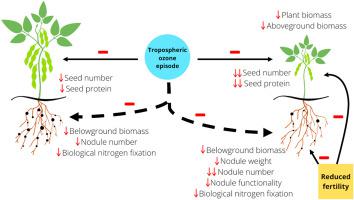Environmental Pollution ( IF 7.6 ) Pub Date : 2020-11-22 , DOI: 10.1016/j.envpol.2020.116117 Lucio Biancari 1 , Clara Cerrotta 2 , Analía I Menéndez 1 , Pedro E Gundel 3 , M Alejandra Martínez-Ghersa 1

|
Driven by human activities, air pollution and soil degradation are threatening food production systems. Rising ozone in the troposphere can affect several physiological processes in plants and their interaction with symbiotic microorganisms. Plant responses to ozone may depend on both soil fertility and the ontogenetic stage in which they are exposed. In this work, we studied the effects of ozone episodes and soil fertility on soybean plants. We analysed soybean plant responses in the production of aboveground and belowground biomass, structural and functional attributes of rhizobia, and seed production and quality. The experiment was performed with plants grown in two substrates with different fertility (commercial soil, and soil diluted (50%, v/v) with sand). Plants were exposed to acute episodes of ozone during vegetative and reproductive stages. We observed that ozone significantly reduced belowground biomass (≈25%), nodule biomass (≈30%), and biological nitrogen fixation (≈21%). Plants exposed to ozone during reproductive stage growing in soil with reduced fertility had lower seed production (≈10% lower) and seed protein (≈12% lower). These responses on yield and quality can be explained by the observed changes in belowground biomass and nitrogen fixation. The negative impact of ozone on the symbiotic interaction with rhizobia, seed production and quality in soybean plants were greater in soils with reduced fertility. Our results indicate that food security could be at risk in the future if trends in ozone concentration and soil degradation processes continue to increase.
中文翻译:

对流层高臭氧事件会降低低肥力土壤上大豆 (Glycine max (L.) Merr.) 的结瘤、种子产量和质量
在人类活动的推动下,空气污染和土壤退化正在威胁粮食生产系统。对流层中臭氧的上升会影响植物的多种生理过程及其与共生微生物的相互作用。植物对臭氧的反应可能取决于土壤肥力和它们所暴露的个体发育阶段。在这项工作中,我们研究了臭氧事件和土壤肥力对大豆植物的影响。我们分析了大豆植物在地上和地下生物量生产、根瘤菌的结构和功能属性以及种子产量和质量方面的反应。该实验是在两种具有不同肥力的基质(商业土壤和用沙子稀释的土壤(50%,v/v))中生长的植物进行的。植物在营养和繁殖阶段暴露于臭氧的急性发作中。我们观察到臭氧显着减少了地下生物量(约25%)、结核生物量(约30%)和生物固氮(约21%)。在繁殖阶段暴露于臭氧的植物在肥力降低的土壤中生长时,其种子产量(大约降低 10%)和种子蛋白质(大约降低 12%)较低。这些对产量和质量的反应可以通过观察到的地下生物量和固氮的变化来解释。在肥力降低的土壤中,臭氧对大豆植株与根瘤菌的共生相互作用、种子产量和质量的负面影响更大。我们的研究结果表明,如果臭氧浓度和土壤退化过程的趋势继续加剧,未来粮食安全可能面临风险。









































 京公网安备 11010802027423号
京公网安备 11010802027423号